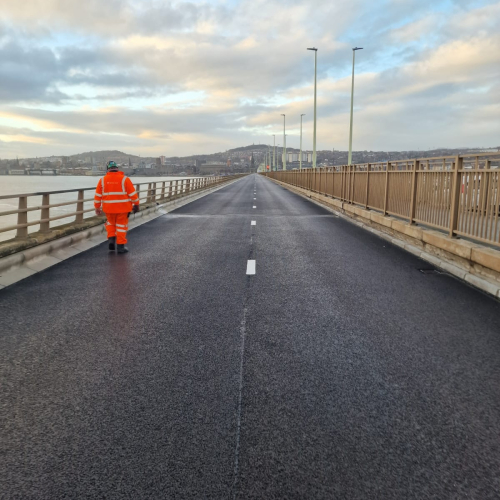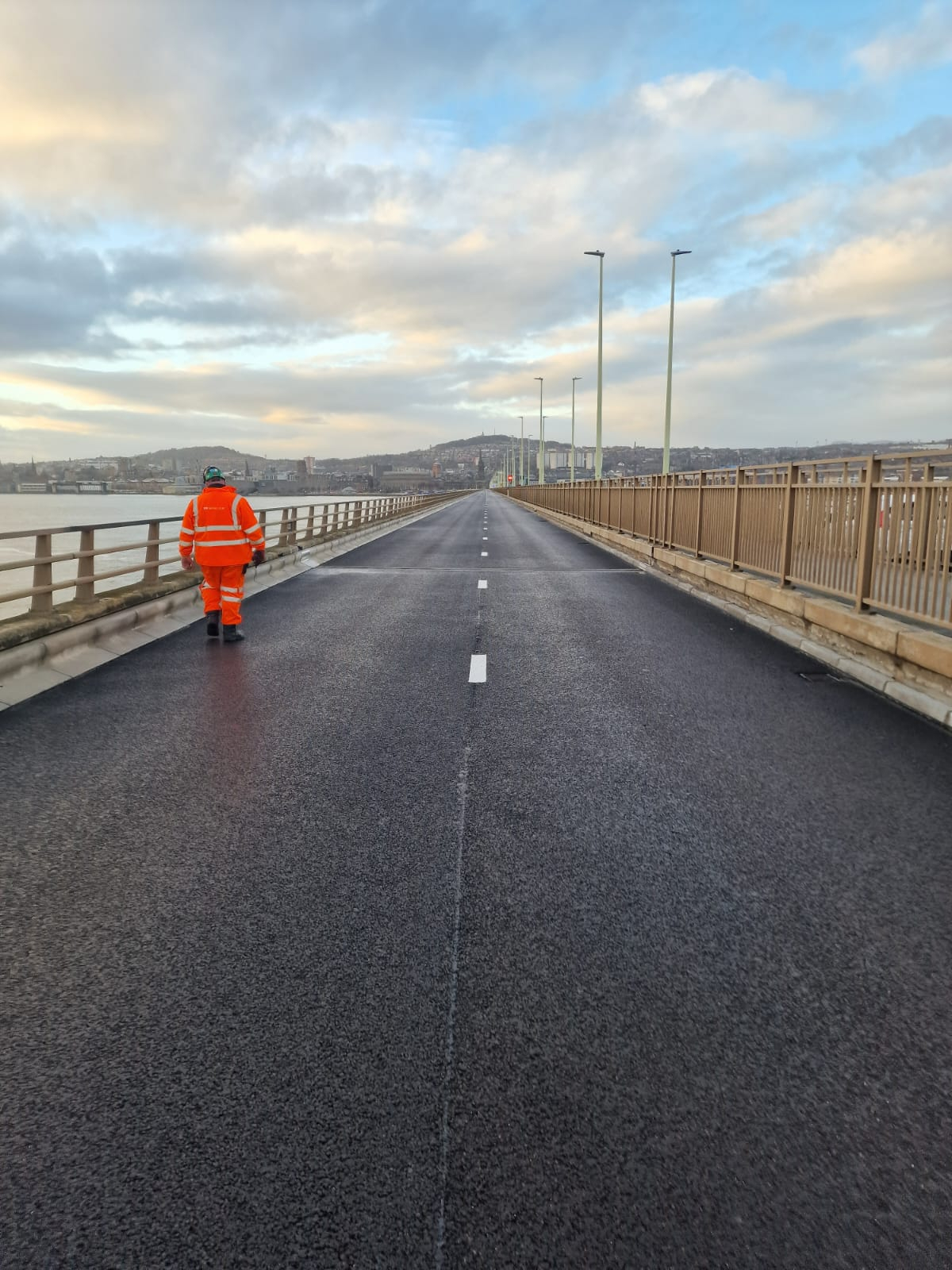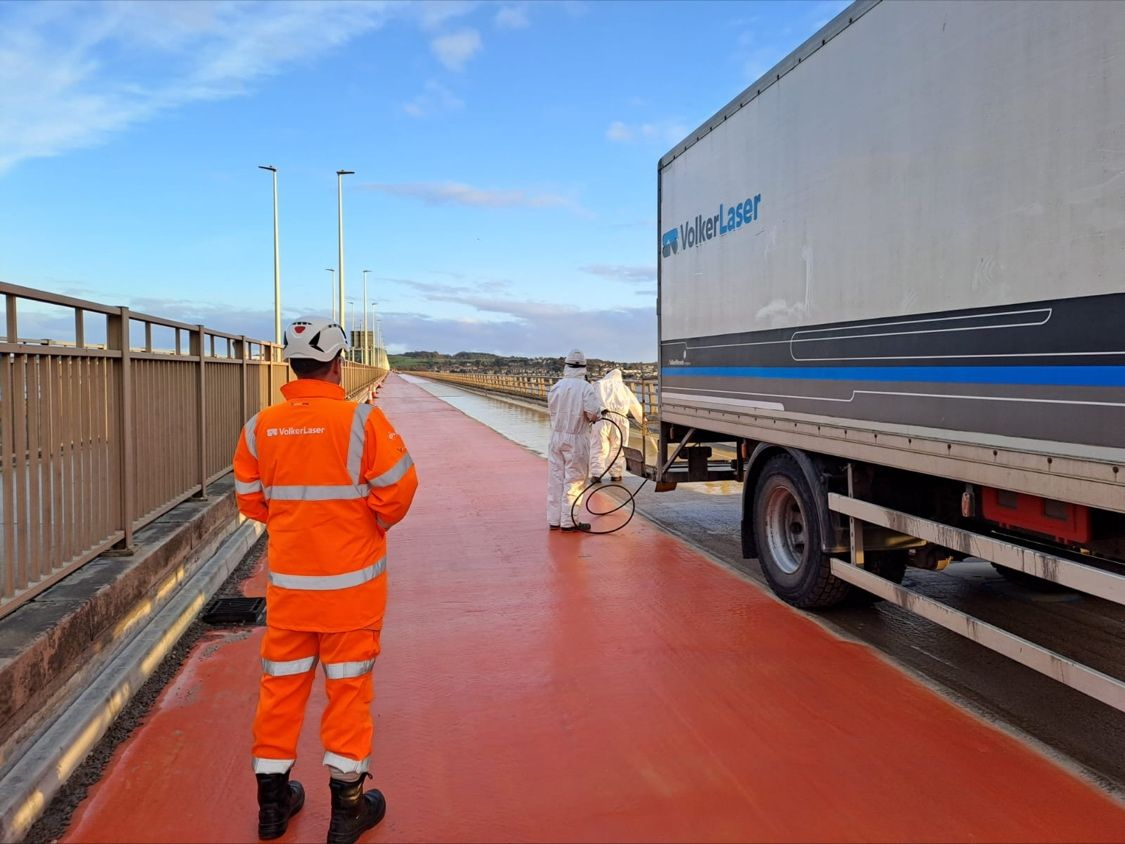Transforming Tay Road Bridge
Since January 2023, VolkerLaser has been working on behalf of VolkerStevin with the Tay Road Bridge Joint Board to carry out restoration works to Tay Road Bridge, a key transport link connecting Fife to Dundee. Since its construction in 1966, the bridge has faced decades of wear and tear, and exposure to the harsh Scottish elements, and the time had come for its deck to receive a well-earned refurbishment.


The project has been split into two phases, with the scope of works being deck concrete repair, soffit concrete repair, waterproofing, new surface and sub-surface drainage, kerb installation, resurfacing, expansion joint installation, and refreshed road markings.
The restoration process began with the removal of the existing surfacing. The 2.3km deck was scraped, reducing the surfacing down to a depth of 10/20mm and the remaining depth was scraped with 360 excavator buckets to minimise any potential damage caused by the planing machine. Simultaneously, kerbs on both sides of the northbound carriageway were removed.
The next stage involved fine milling and captive blasting. Fine milling utilises a small surface machine to remove bitumen and contaminated concrete, achieving a smooth surface. During the process, boot prints from 1960’s workers were revealed on the concrete slab for the first time in nearly 60 years, appearing as shallow bitumen-filled imprints. The team documented their findings by taking pictures, comparing their boot sizes to the construction workers that had been a part of laying the bridge’s original surfacing. As well as the historical nature of the find, it demonstrates how a properly sealed deck can preserve the underlying concrete.
The captive blasting process utilised ride-on shot blasters which fire metal ball bearings, preparing the smoothened concrete surface for waterproofing applications. This method prevented the spread of dust, and any residue was safely contained and removed.
After successfully removing the existing surfacing, thorough hammer tests and visual inspections were conducted to determine the extent of the repairs needed, prior to concrete works commencing.
Once fully assessed, hydro-demolition was used to remove any affected area, and VolkerLaser implemented manned exclusion zones to ensure public safety and allow pedestrians to continue to use the central walkway – a vital throughfare for pedestrians and cyclists. The captured wastewater from the hydro-demolition process was treated and discharged safely.
Once hydro-demolition works were complete, the team began concrete repairs, adding XP4 sacrificial anodes to enhance the structures durability. Soffit repairs were carried out to the cantilevered section of the bridge using an underslung Haki scaffolding system to provide a safe and stable working platform. A total of eight repairs were completed to the northbound, western-facing parapet, and 12 repairs are scheduled for the southbound, eastern-facing parapet in phase two.

The deck underwent a final blast to ensure the surface was ready for waterproofing. 43 new sub-surface drainage systems were installed across the deck ends, and a further 86 additional drainage systems were installed, along with approximately 120 gully gratings across the deck. A comprehensive drainage coring strategy was implemented to avoid the reinforcement within the deck.
The process of the waterproofing application involved applying a two-coat system to the bridge deck, consisting of a primer, a yellow one-coat eliminator, and white on-coat eliminator, and a red bond-coat to secure the surfacing to the deck. Additionally, six buried joints were installed which seals the joint to further prevent water penetration into the concrete. The team also installed HB3 kerbs to lane two, and Trief High Containment kerbs to lane one – covering nearly 5km in total during phase one alone.
With waterproofing and drainage enhancements in place, VolkerLaser reinstated the asphalt surfacing, following the installation of 43 mechanical expansion joints to allow the deck sections to move as designed. Once the surfacing was installed and the new road markings applied, the team removed traffic management – marking the completion of phase one.
Working alongside traffic management contractors, VolkerLaser implemented a robust traffic management plan throughout the works, which included establishing contraflow systems, which ensured a continuous flow of traffic throughout construction activities. Further measured included an access and egress for delivery drivers, site security to prevent unauthorised access, and a comprehensive recovery plan to address any breakdowns effectively.
In a region prone to high winds, a unique high-wind procedure was implemented to safely turn high-sided vehicles, with a designated area to enable them to perform U-turns during any extreme weather conditions.
During the first phase of repairs, VolkerLaser has completed approximately 32m3 of concrete repair work, with a total of 46m3 scheduled for the entire project.
The second phase is due to begin in March 2024 and will include the same scope of work to the southbound carriageway, with the addition of resurfacing the entrance and exit ramps towards Dundee. Phase two works are set to last approximately six months.
